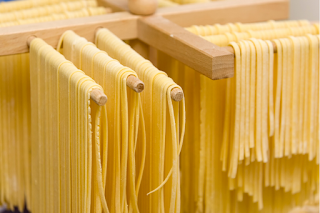Drying the pasta
Drying is the most delicate phase in the preparation of pasta. It is no coincidence that the most important production centres from the 1400s to the 1700s were Liguria and Campania with "exceptional" climatic conditions and sunshine. The areas of Gragnano and Torre Annunziata were the Neapolitan coastal areas of excellence, where thanks to the west wind it was possible to naturally dry pasta. The scan was decided and controlled by the figure of the "head pasta maker", a connoisseur of an art handed down from generation to generation.
After the "wrapping", exposure to the sun in courtyards or terraces, the paste was left to "revive" in cold and slightly damp rooms (usually cellars), to prevent cracks from being produced on its surface. This was followed by the final drying, obtained by exposing the paste to drafts in rooms in which the passage of the winds was empirically regulated by opening and closing the windows.
In the early 1900s, drying became mechanized, progressively reducing the time needed to complete the production cycle, thus spreading the pasta industry throughout Italy.
It was precisely in this period of time that the Neapolitan industry experienced its maximum development, and exports reached levels never touched before. Until the outbreak of the First World War, the most renowned brands of macaroni imported into America came almost exclusively from Gragnano and Torre Annunziata.
The pasta dryer net is a typically Italian product consisting of a wooden frame and a net suitable for food contact, used to roll out and let fresh pasta dry. Perfect when you don't want to use freshly made pasta but want to let it dry for future consumption. In this way, you can let it dry perfectly before returning it to the freezer, in the case of stuffed pasta, or to store it in a dry place at the right temperature in the case of pasta, from tagliatelle to spaghetti to local specialties.
It is a tool that is still widely used, especially in those territories where authenticity and traditional flavors are preserved thanks to the use of manual tools already used by grandmothers. To make the perfect homemade pasta, you can't help but use the wooden pasta dryer net.



No comments:
Post a Comment